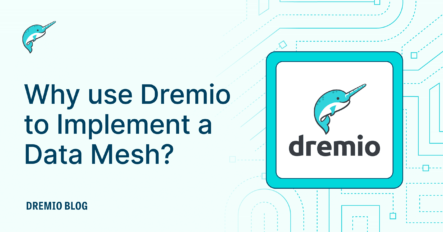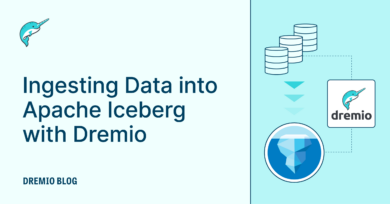
Organizations continuously seek architectures that can effectively handle modern data ecosystems' complexities. Enter the concept of a data mesh, an architectural paradigm that alters the division of labor in how data is handled, processed, and delivered. This article explores why you should implement a data mesh with Dremio, a cutting-edge data lakehouse platform.
Data mesh shifts the focus from centralized data management to a more distributed, domain-oriented approach. This shift is a technological change and a rethinking of data culture and architecture. In this context, Dremio emerges as a potent tool that aligns perfectly with the principles of data mesh, offering capabilities that support and enhance this innovative approach.

Understanding Data Mesh
Data mesh is an architectural and organizational paradigm that treats data as a product, emphasizing domain-oriented decentralized data ownership and architecture. It's built on four fundamental principles:
- Domain-oriented decentralized data ownership and architecture: Data is managed and owned by domain-specific teams, breaking down the silos and centralization typical in traditional data management.
- Self-serve data infrastructure as a platform: Infrastructure is set up to empower domain teams to handle their data products independently, fostering a self-service model.
- Product thinking with data: Data is treated as a product that focuses on the users' needs, ensuring that it's accessible, reliable, and fit for purpose.
- Federated computational governance: Governance is applied across domains, ensuring data interoperability and standardization while allowing domain flexibility.
Benefits of Implementing a Data Mesh
Implementing a data mesh offers several advantages:
- Increased agility and scalability: By decentralizing data ownership, organizations can scale more effectively and adapt quickly to changing needs.
- Enhanced data quality and accessibility: With data as a product, there's a greater focus on quality, relevance, and accessibility, leading to more valuable data insights.
- Improved collaboration and innovation: The domain-oriented approach fosters collaboration across different teams, sparking data usage and analysis innovation.
The Role of Dremio in Data Mesh Architecture
Dremio's architecture and features align seamlessly with the principles of data mesh, making it an ideal choice for implementing this model. Here’s how Dremio supports each principle:
- Domain-oriented architecture: Dremio facilitates the creation of domain-specific data models, enabling decentralized data ownership while providing a unified view across domains.
- Self-serve data infrastructure: With its user-friendly interface and self-service capabilities, Dremio empowers domain teams to manage and access their data autonomously.
- Data as a product: Dremio’s data lakehouse management features enhance the quality and accessibility of data, allowing for easy iteration, collaboration, and disaster recovery and ensuring it is ready for consumption across the organization.
- Federated governance: Dremio supports governance policies that can be applied across different domains, ensuring standardization and compliance.
- Unified data access: Dremio supports building data products across data lakes, warehouses, and databases, allowing each domain to curate their existing data with minimal friction.

Planning the Implementation
Implementing a data mesh with Dremio involves careful planning:
- Assess organizational readiness: Evaluate the current internal data landscape and readiness for a domain-oriented approach.
- Identify domain boundaries: Define clear boundaries and responsibilities for each data domain within the organization.
- Conduct Technical audits: Find out where data will live across domains to ensure the data lives in sources supported by Dremio.
Technical Setup with Dremio
Create your Dremio cluster either by:
- Connecting your existing AWS/Azure data lake to a cloud-managed Dremio Cloud instance
- Using the Dremio Helm chart to deploy Dremio quickly to a Kubernetes cluster
You can get started by visiting this page, and if you want to see Dremio isolated on your laptop first, try out this tutorial.
Once your Dremio instance is running, you can:
- Create user accounts for each Domain Owner
- Grant them read/write access to a folder for their data product
- Grant them access to connect data sources
- Domain Owners can connect the relevant sources
- Domain team can then curate a semantic layer for their data product
- Domain Owners can grant consumers access to their data product
Data Governance and Compliance
In a data mesh, governance is key:
- Decentralized governance: Establish governance practices that allow autonomy within domains while maintaining overall data standards.
- Leveraging Dremio’s security features: Utilize Dremio’s security and compliance features to protect data across all domains using role-based, column-based, and row-based access controls.
Best Practices for Data Mesh Implementation
Implementing a data mesh architecture, particularly with Dremio, requires a strategic approach to ensure success. Here are some best practices to consider:
Gradual implementation: Start with a small-scale implementation. Choose a specific domain to pilot the data mesh concept, allowing for learning and adjustments before expanding to other areas.
Emphasize domain expertise: Ensure that each domain team has the necessary expertise and understanding of their data. This expertise is crucial for maintaining the quality and relevance of data products.
Prioritize data governance: Establish clear data governance policies from the outset. Maintaining consistent data quality, security, and compliance standards is essential, even in a decentralized environment.
Foster a culture of collaboration: Encourage regular communication and collaboration between domain teams. This collaboration is critical to ensuring the decentralized data products integrate well and deliver value across the organization.
Invest in training and support: Provide adequate training for team members on the data mesh concept and Dremio’s platform. Continuous support and knowledge sharing are critical for the smooth functioning of a data mesh.
Iterative approach to data product development: Treat data assets as products in an iterative process. Regularly gather feedback from data consumers and refine the data products accordingly.
Leverage Dremio’s features effectively: Fully use Dremio’s capabilities, such as data virtualization and self-service access, to empower domain teams and enhance data accessibility.
Monitor and measure success: Implement metrics and KPIs to measure the success of the data mesh implementation. Continuous monitoring can help identify areas for improvement and gauge the overall impact on the organization's data capabilities.
Stay adaptable to change: The data landscape constantly evolves, so it’s essential to remain flexible and open to adapting the data mesh model as new technologies and practices emerge.
By following these best practices, organizations can effectively implement a data mesh with Dremio, paving the way for more agile, decentralized, and efficient data management and analytics.

Conclusion
Implementing a data mesh with Dremio can significantly enhance an organization’s data management capabilities. Dremio’s alignment with data mesh principles and powerful features make it an excellent tool for this modern data architecture.
Sign up for AI Ready Data content


